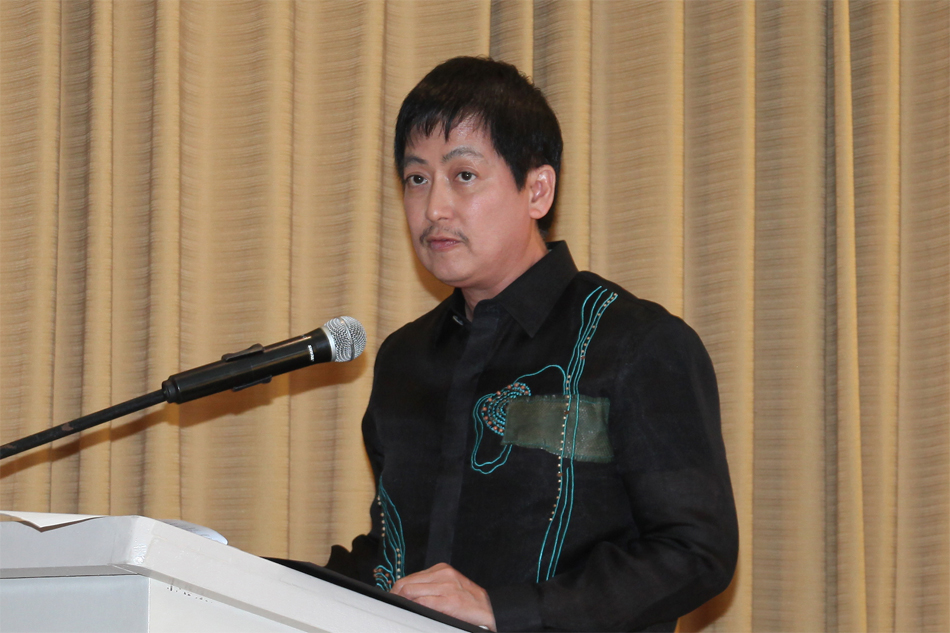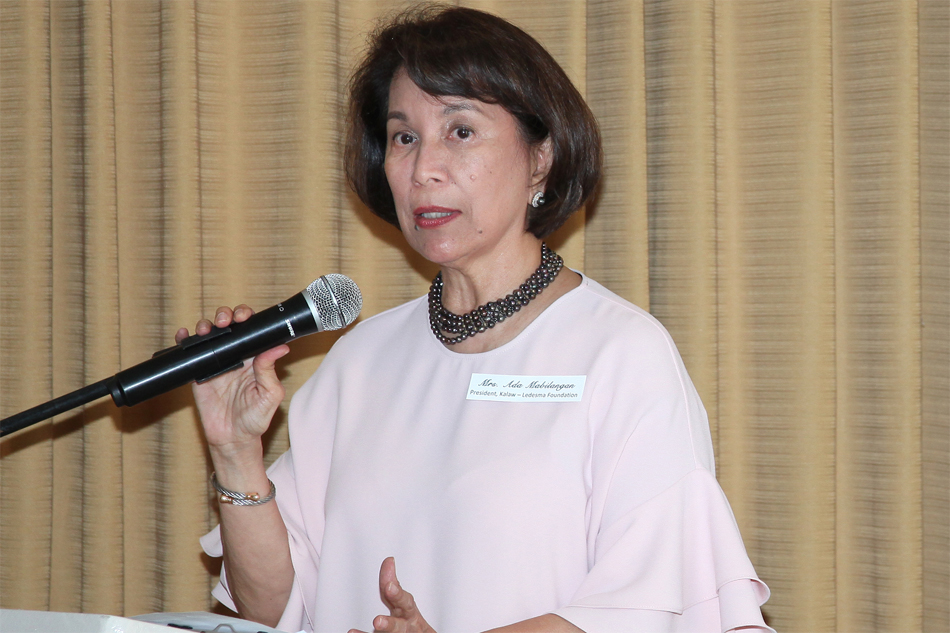New book chronicles life of 'Mother of Philippine Modern Art' | ABS-CBN
ADVERTISEMENT

Welcome, Kapamilya! We use cookies to improve your browsing experience. Continuing to use this site means you agree to our use of cookies. Tell me more!
New book chronicles life of 'Mother of Philippine Modern Art'
New book chronicles life of 'Mother of Philippine Modern Art'
Angelo G. Garcia
Published Jun 11, 2017 08:01 AM PHT
MANILA – “Purita Kalaw-Ledesma was a lifelong student, curious and open-minded. She was not afraid of change. She believed that each generation faced its own set of challenges to resolve in its own way,” writes Ada Ledesma Mabilangan in her introduction about her mother in the book, “The Life and Times of Purita Kalaw-Ledesma.”
MANILA – “Purita Kalaw-Ledesma was a lifelong student, curious and open-minded. She was not afraid of change. She believed that each generation faced its own set of challenges to resolve in its own way,” writes Ada Ledesma Mabilangan in her introduction about her mother in the book, “The Life and Times of Purita Kalaw-Ledesma.”
On the opposite page of the introduction is a photo of Vicente Manansala’s “Bois du Boulogne.” And as one flips through the book’s pages, more images of artworks from some of the country’s best artists pop up like Alfredo Roces, Napoleon Abueva, Mauro Malang Santos, Cesar Legaspi, Hernando R. Ocampo, and many more.
On the opposite page of the introduction is a photo of Vicente Manansala’s “Bois du Boulogne.” And as one flips through the book’s pages, more images of artworks from some of the country’s best artists pop up like Alfredo Roces, Napoleon Abueva, Mauro Malang Santos, Cesar Legaspi, Hernando R. Ocampo, and many more.
There are also portraits of Kalaw-Ledesma including a 1977 work of Victorio Edades used as the cover. The artworks are from her personal collection.
There are also portraits of Kalaw-Ledesma including a 1977 work of Victorio Edades used as the cover. The artworks are from her personal collection.
But who is Purita Kalaw-Ledesma?
But who is Purita Kalaw-Ledesma?
ADVERTISEMENT
She was a writer, an art patron, and was one of the most influential people in the local art world during her time. Dubbed as the “Mother of Philippine Modern Art,” she founded and led the Art Association of the Philippines.
She was a writer, an art patron, and was one of the most influential people in the local art world during her time. Dubbed as the “Mother of Philippine Modern Art,” she founded and led the Art Association of the Philippines.
Authored by art historians Patrick Flores, Clarissa Chikiamco, Eileen Legaspi-Ramirez, and edited by Purissima Benitez-Johannot, the book chronicles Kalaw-Ledesma’s life during a difficult period in Philippine modern art.
Authored by art historians Patrick Flores, Clarissa Chikiamco, Eileen Legaspi-Ramirez, and edited by Purissima Benitez-Johannot, the book chronicles Kalaw-Ledesma’s life during a difficult period in Philippine modern art.
She was a dedicated art patron, collecting 83 volumes of art documents from newspaper clippings to posters.
She was a dedicated art patron, collecting 83 volumes of art documents from newspaper clippings to posters.
“There hasn’t been a book on her because Purita wrote books. She used those 83 volumes of archives as material to write her books. She was peripherally part of other books but what art historians study when they go to school are the stories that she has written in those books.
“There hasn’t been a book on her because Purita wrote books. She used those 83 volumes of archives as material to write her books. She was peripherally part of other books but what art historians study when they go to school are the stories that she has written in those books.
“My way of thanking her, I told her I would write about her life, the overview, then I would edit the book. And we’re very lucky to have the leading art historians writing about it,” shared Benitez-Johannot.
“My way of thanking her, I told her I would write about her life, the overview, then I would edit the book. And we’re very lucky to have the leading art historians writing about it,” shared Benitez-Johannot.
According to Vibal Foundation executive director Gaspar Vidal, this book is a great documentation of where Philippine modern art started. The publication of the book was made possible by Vibal Foundation, Kalaw-Ledesma Foundation, and BDO Private Bank.
According to Vibal Foundation executive director Gaspar Vidal, this book is a great documentation of where Philippine modern art started. The publication of the book was made possible by Vibal Foundation, Kalaw-Ledesma Foundation, and BDO Private Bank.
“It’s great documentation. These documents the early years when they were struggling, when they’re literally poor. Manila was totally devastated during World War II, so everything has to be redone. What we know as modern art now was born during the post war era.”
“It’s great documentation. These documents the early years when they were struggling, when they’re literally poor. Manila was totally devastated during World War II, so everything has to be redone. What we know as modern art now was born during the post war era.”
“It is basically what we consider modern, what we consider artistic can be attributed to her taste. She really has close friends like Arturo Luz, Fernando Zobel, and Roberto Chabet. Before, people didn’t think that abstract art was worth looking at. But she changed the dynamics and the discourse, the narrative. She changed the way we look at things,” Vibal said.
“It is basically what we consider modern, what we consider artistic can be attributed to her taste. She really has close friends like Arturo Luz, Fernando Zobel, and Roberto Chabet. Before, people didn’t think that abstract art was worth looking at. But she changed the dynamics and the discourse, the narrative. She changed the way we look at things,” Vibal said.
Born on February 2, 1914 (died April 29, 2005), Kalaw-Ledesma supported Filipino modern artists after World War II when the country was still recovering from the devastation.
Born on February 2, 1914 (died April 29, 2005), Kalaw-Ledesma supported Filipino modern artists after World War II when the country was still recovering from the devastation.
“She never took things for granted, she always worked hard. I think this is the characteristic of many Filipinos who came out from the war, they don’t take things for granted and they’re not afraid of hard work. Purita was certainly never afraid of tackling challenge. She lived in tumultuous times after the war and she had the strength,” said Benitez-Johannot.
“She never took things for granted, she always worked hard. I think this is the characteristic of many Filipinos who came out from the war, they don’t take things for granted and they’re not afraid of hard work. Purita was certainly never afraid of tackling challenge. She lived in tumultuous times after the war and she had the strength,” said Benitez-Johannot.
It took the team two years to put the book together. For Benitez-Johannot, this book is important because of its significance in the study of Philippine art in general.
It took the team two years to put the book together. For Benitez-Johannot, this book is important because of its significance in the study of Philippine art in general.
“I think it is important to go back to what we would call, birthing of modernism in the Philippines. Many of our young people find that information online and it’s easily disposable. Writing a book would keep something in the library permanently for other people to rewrite later.
“I think it is important to go back to what we would call, birthing of modernism in the Philippines. Many of our young people find that information online and it’s easily disposable. Writing a book would keep something in the library permanently for other people to rewrite later.
“Our authors here have rewritten the history of art based just based on our archives. While she wrote her version of the history of art modernism, the three others wrote their own point of view. I think that’s the whole point of having archives, to invite people to come in a rethink the narrative. There’s not just one history, there are many stories,” she said.
“Our authors here have rewritten the history of art based just based on our archives. While she wrote her version of the history of art modernism, the three others wrote their own point of view. I think that’s the whole point of having archives, to invite people to come in a rethink the narrative. There’s not just one history, there are many stories,” she said.
ADVERTISEMENT
ADVERTISEMENT






